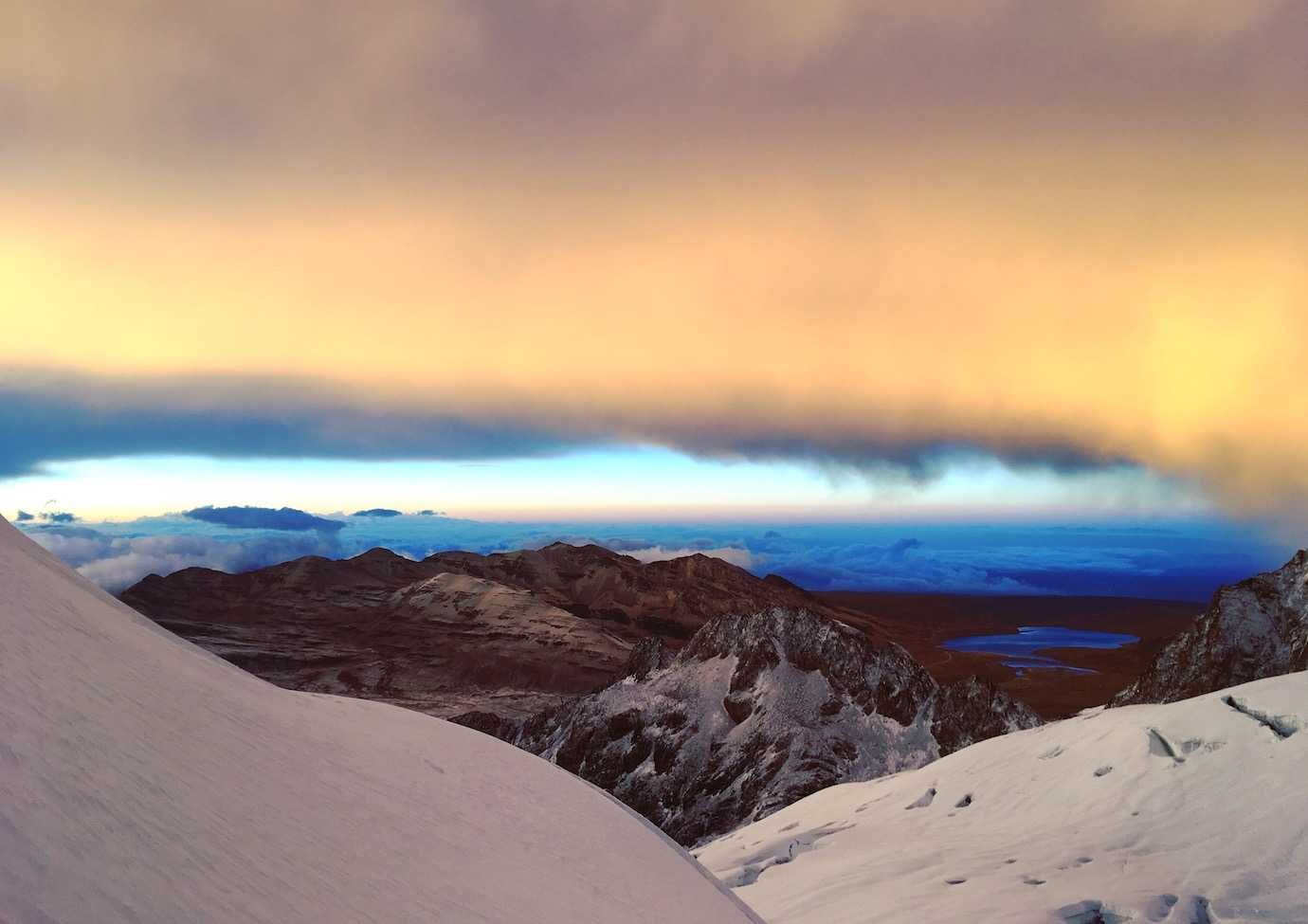
On a walking tour in Peru’s Arequipa, our guide firmly believed that going over 6000m once in your life was a must-do bucket list experience. Located in the Cordillera Real near La Paz and with a 6088m summit, Huayna Potosí was perfect for making the 6000m dream a reality.
Described as a relatively easy climb and beginner friendly, my friend was the driving force behind us climbing Huayna Potosí. Keeping in mind that I’m not the most activity brave person, persuading myself to climb Huayna Potosí took a bit of work. I decided to do it firstly, because I didn’t want to stop my friend from doing it, and secondly to push myself out my comfort zone (because we all need to do that once in a while!).
Read on for a day by day trip breakdown, to find out if we reached the summit and for my personal Huayna Potosí climbing tips.
Our Huayna Potosí experience
Day One
Day One is geared towards absolute beginners. Leaving La Paz at 9am, we arrived to base camp at 10.30 and had an early lunch. We then walked to a nearby glacier to practice for the climbing to come on Day Three. Our guide, Siberio, showed us how the equipment worked and we had a practice run walking on the glacier learning ice climbing techniques.
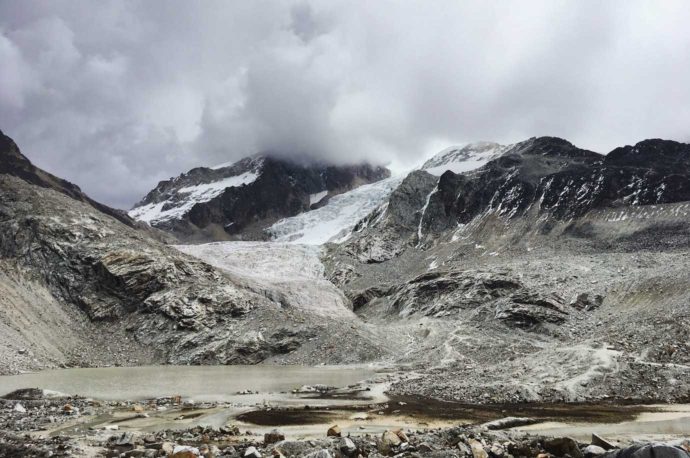
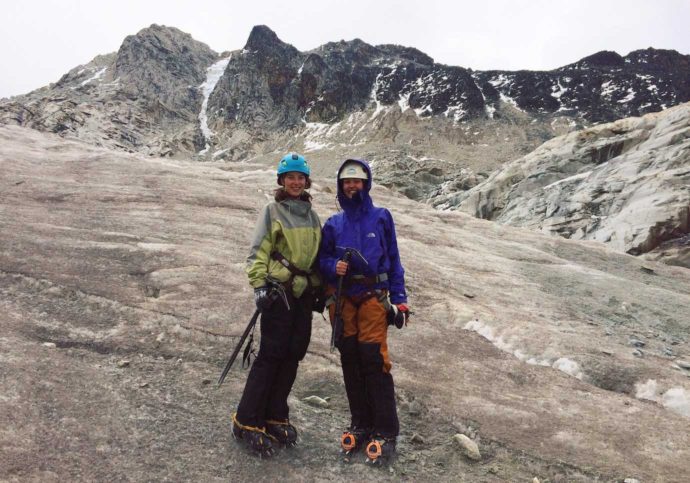
We also got to have a go at climbing an ice wall. I can definitely say I wasn’t a natural. I got stuck half way up on an outcropping of ice on my first try and hung there for a while until I managed to get over it and reach the top. For some reason, I even had a second go which again involved me getting stuck for a while before reaching the top.
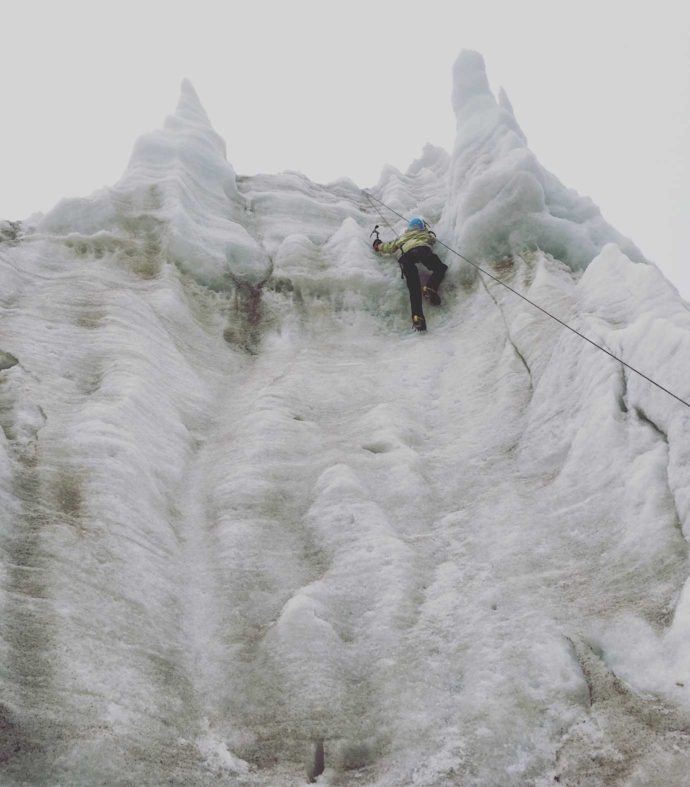
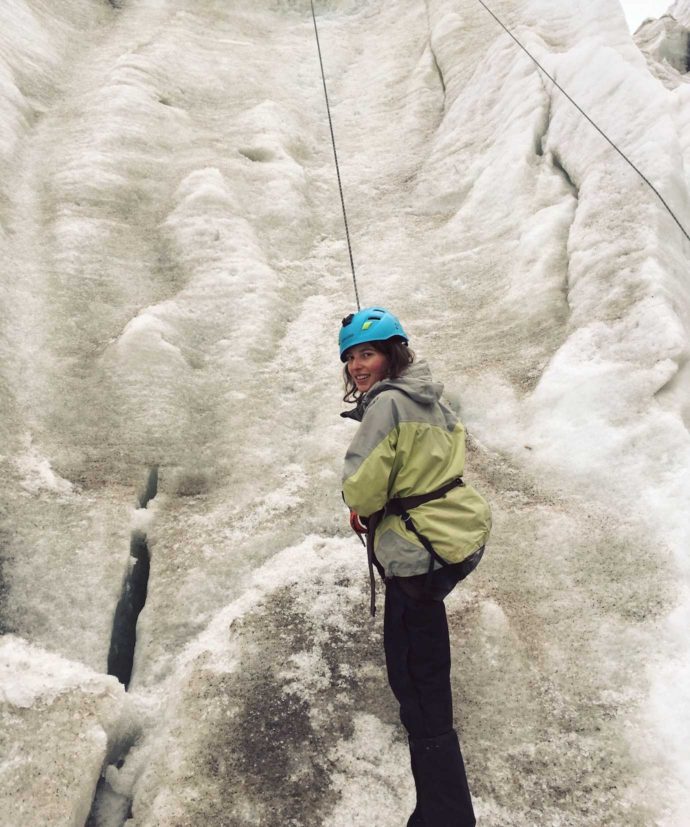
Day Two
The aim of Day Two is to reach high camp (5100m). The climb is steep but distance wise not that far. According to our guide, it approximately takes around 2 hours. We arrived at high camp at 11.30 taking us 3 hours. I got the impression that most people are faster than we were.
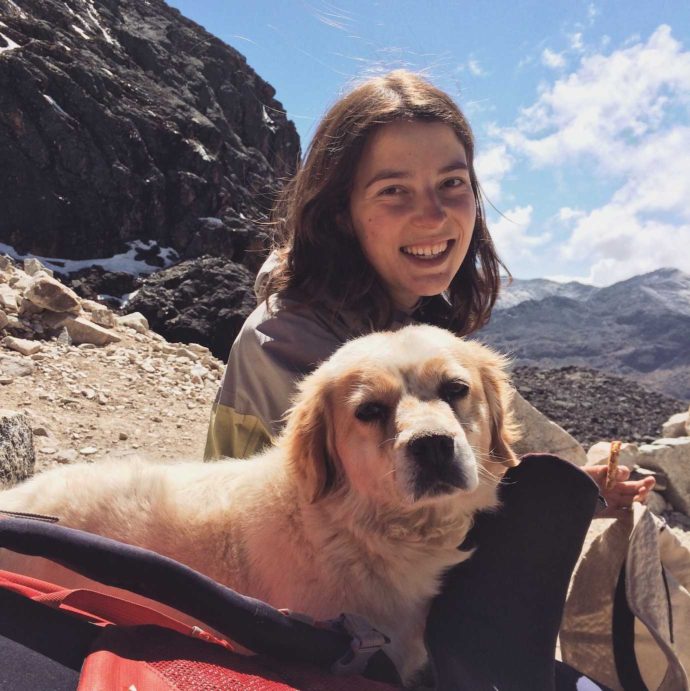
With our pace maker!
On the walk to high camp, you will be carrying all your equipment for the next day’s summit climb. For us, this included heavy boots, crampons, harness, ice axe and a sleeping bag for the night, as well as our layers, snacks, water etc. My bag was extremely heavy, I’d recommend leaving what you can at base camp to lighten your load.
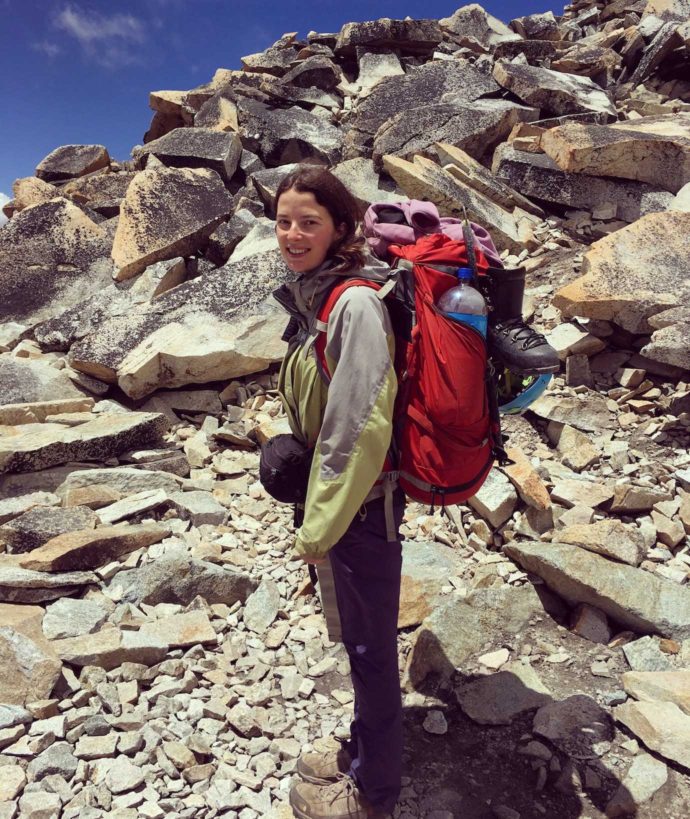
Once at high camp, we had lunch and spent the rest of the afternoon chilling, eating popcorn and chatting to fellow climbers arriving at the camp. After an early dinner, around 4.30pm, it was time to get our stuff ready for the ascent to the summit and go to bed at 6pm.
Day Three
To reach the summit for sunrise it’s an early early start. For most people, you’ll start climbing at 1am and it takes approximately 6 hours. Given our slow pace, we started an hour earlier at 12am. Leaving high camp involves walking over a few rocky patches before you reach the snow and the ascent starts. Seeing the twinkling city lights of La Paz in the distance and looking up at the thousands of stars shining in the sky was really cool and a touch magical.
I don’t really have a concept of time and how long we took; all I know is that we were very slow and paused frequently to refuel on snacks, not wanting to turn back because we were lacking energy. We successfully climbed the steep incline (or ice wall as I like to call it), which we’d prepared for on Day One – although I’m sure my technique left much to be desired.
We then continued walking until we came across a crevasse. I’d mentally prepared myself for the ice wall, so I was slightly annoyed that our guide hadn’t warned us about the crevasses. Looking back, the crevasse wasn’t that big, it was a big step or small jump from one side to the other. However, in the pitch dark and wearing painful ski type boots, I couldn’t bring myself to jump. I was scared and not confident, all I could picture was falling and that was the moment I reached my out my comfort zone limit. Multiple pep talks didn’t help, especially when our guide mentioned there were more crevasses further up.
Having reached my limit, we disappointedly turned back and started our descent down just as a mini blizzard began. Snow really does sting when it hits you in the face! We climbed down the ice wall as dawn was arriving. I much preferred the cover of darkness – that way I couldn’t see the drop! The rest of the walk down was beautiful, all the snow crystals sparkling and glittering in the sunshine.
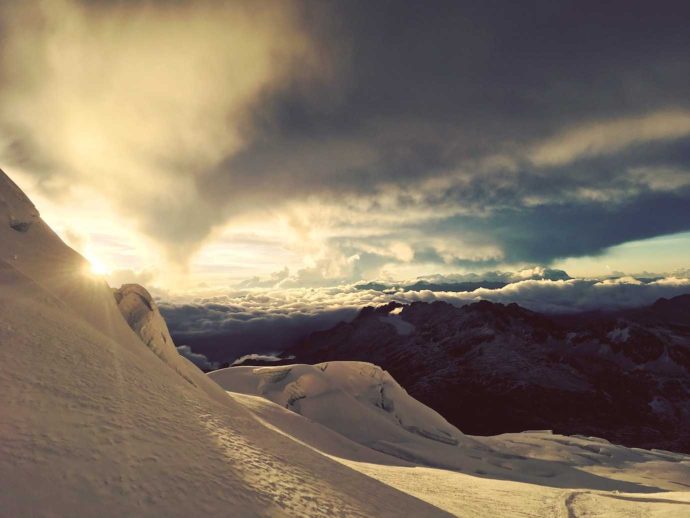
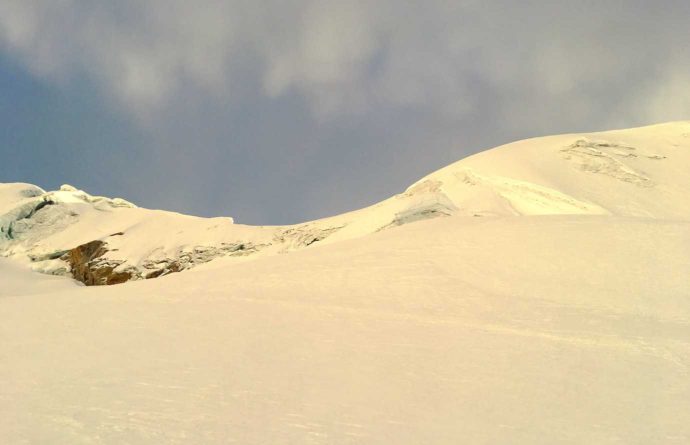
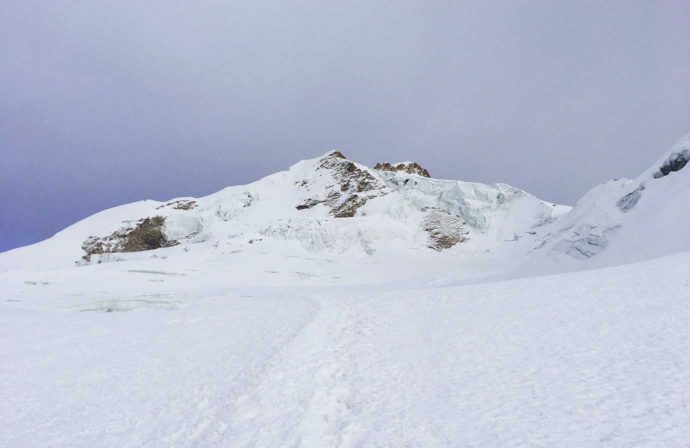
Back at high camp we had breakfast and then started our rocky steps descent to base camp. It had started to snow again and it was a careful and steady walk down on the slippery snow covered rocks.
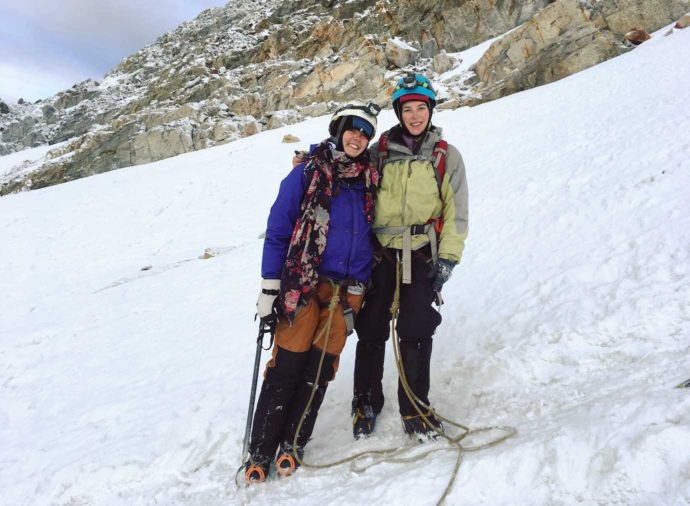
At base camp we were picked up and driven back to La Paz, arriving back at around 1pm. We headed straight to our favourite cafe, Cafe del Mundo, for some well deserved food. For me, that was a nutella crepe.
10 Tips for climbing Huayna Potosí
#1 Acclimatise
Huayna Potosí is high! Aid your chances of reaching the summit by giving yourself time to acclimatise. We’d been slowly adjusting to high altitudes throughout our time in Peru, so we only gave ourselves a day in La Paz before having a go. However, if you’re flying into La Paz from low places do spend a few days in La Paz adjusting.
#2 Eat the meals and snacks provided and take your own extra snacks
It’s not uncommon to lose your appetite at high altitude, especially super early in the morning. Make sure to eat the food at mealtimes and snack frequently. We met lots of people who didn’t reach the top because they lacked the energy. Don’t let this be you.
#3 Check what equipment your agency gives you
You’ll need specialist climbing equipment for the final ascent from high camp to Huayna Potosí’s summit. Our agency gave us waterproof trousers and coat, all the climbing equipment (crampons, boots, harness, helmet, ice axe, headlamp, thick gloves), and a rucksack.
The mountaineering boots reminded me strongly of downhill ski boots, they were plastic and stiff. Having always struggled in ski boots, I knew my feet and shins weren’t going to enjoy the ascent. We were given woolly socks to wear inside the boots but honestly they didn’t help my feet much. If you can try and get yourself a good pair of thick woolly socks, it will make a considerable difference to your climbing experience. To this day, I think part of the reason I turned back was due to the pain my feet and shins were in and how as a result I didn’t trust my feet to jump the crevasse.
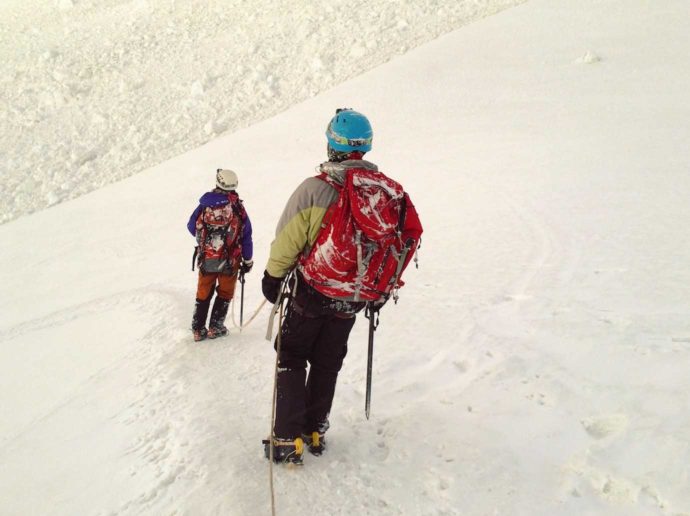
#4 Bring layers
You’re going to reach high altitudes and the weather can change extremely quickly. Make sure you have layers you can easily put on or take off.
#5 Pack light
It sounds a bit contradictory given I’ve just said bring layers, but you’ll be carrying all your climbing equipment, water, layers, snacks etc, so don’t go too overboard because you’ll need to carry it all to high camp. Looking back, my friend and I could have definitely lightened our load!
#6 Go at your own pace and don’t rush
The worst thing you can do is rush. The altitude and climbing make it challenging enough, so take it slow and walk at your own pace. Our guide liked to joke that we were the slowest pair he’s ever had, I’m not sure he was even joking as we really were super slow – I blame the boots and my bony shins!
That said a plus of going slow was that the altitude didn’t massively affect us and it wasn’t the reason why we didn’t reach the summit.
#7 Don’t choose the cheapest tour agency
There are numerous tour agencies in La Paz all offering the chance to climb Huayna Potosí. If you’re on a budget, like us, cheap is good. However, I’d recommend considering reviews, their equipment, the information they provide as well when picking an agency.
We looked at two agencies and decided against the second one because it seemed they were less interested in our questions and concerns. We went with the first agency and paid more but we were happy doing so because we got a better vibe from them and we were shown the equipment we’d be using etc.
#8 If you do it with someone, remember you’re a team
My friend and I tried climbing Huayna Potosí together. We went into it knowing there were two of us with one guide. This meant that if one of us couldn’t make it, then both of us had to turn back. In our case, I was the one who reached my limit. Back at high camp, I was gutted and couldn’t help but have a cry. Not only did I feel like I’d let myself down, I also felt awful for letting my friend down and stopping her from reaching the top.
Remember you’re a team and that everyone has different limits. It might be disappointing, but it’s not the end of the world. Remember, your positions could always have been reversed.
If you don’t want reaching the summit to be tied to someone else, you’ll need to make sure you have separate guides.
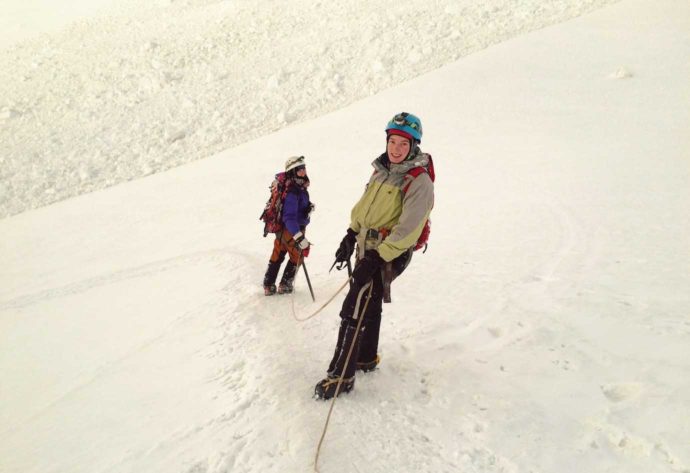
#9 Go with a guide
At 6088m high, Huayna Potosí is challenging both physically and mentally. Unless you’re an experienced climber, then I 100% advise you to go with a guide who confidently knows the area, altitude and terrain. It’s the sensible and safer option to choose.
#10 Two vs Three days for Huayna Potosí
You can climb Huayna Potosí in two or three days. For those with climbing experience, the first day is unnecessary as it’s geared towards teaching the ropes to beginners. We met quite a few people at high camp climbing Huayna Potosí in two days.
Having no prior experience, we chose the three day trip. An advantage to choosing three days is that it helps with acclimatising, you have longer to adjust. Moreover, if you’ve never climbed before or it’s been a long time since you have, I’d really recommend the three days trip.
Final thoughts on Huayna Potosí
I was extremely gutted that I didn’t reach the top of Huayna Potosí. Does that mean I regret attempting it?
Absolutely no way! Despite not reaching the summit for sunrise, Huayna Potosí was my La Paz highlight. If I was to rewind time, I’d do it again. It was still a fantastic and rewarding experience – I went out my comfort zone, climbed an ice wall (for those who know me, this is not a ‘me thing to do’!), went higher than I’ve been before and saw an incredible sunrise over the Cordillera Real mountain range on our descent down.
If you’re in La Paz and considering heading into the Cordillera Real, then Huayna Potosí is the mountain to try. As mentioned earlier, it’s considered a relatively easy climb in comparison to its counterparts and is recommended to complete beginners. However, that doesn’t mean it’s easy. Be prepared to be mentally and physically challenged: steep climbs, hurting bruised feet and shins, ice walls, crevasses, feeling scared and reaching your limits (I reached mine).
Personally, Huayna Potosí’s landscape, gradient and exposure were ultimately too far out my comfort zone. I’ve heard the final push to the summit is narrow, steep and very exposed. I’ve learnt my limits and with that in mind, I really doubt I’d top the summit if I was to try again one day.
Now time has passed, I can look back on my Huayna Potosí experience with a smile on my face knowing I tried my best and challenged myself by going completely outside my comfort zone. I’m really proud of how far I got and will continue to view it as a personal achievement.
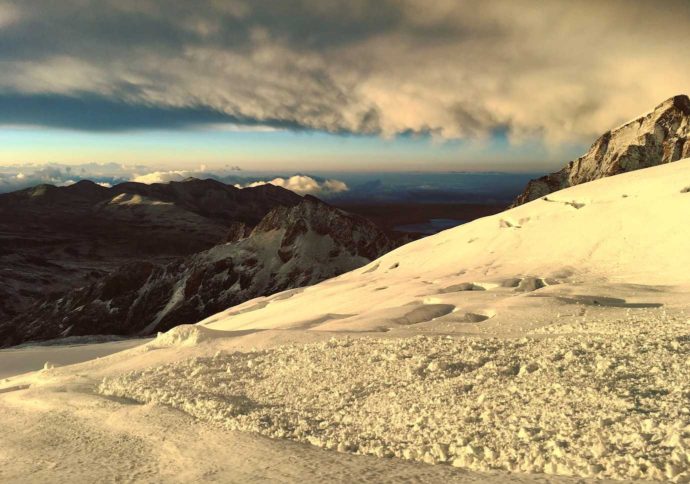
Have you climbed Huayna Potosí? Did you reach the summit?